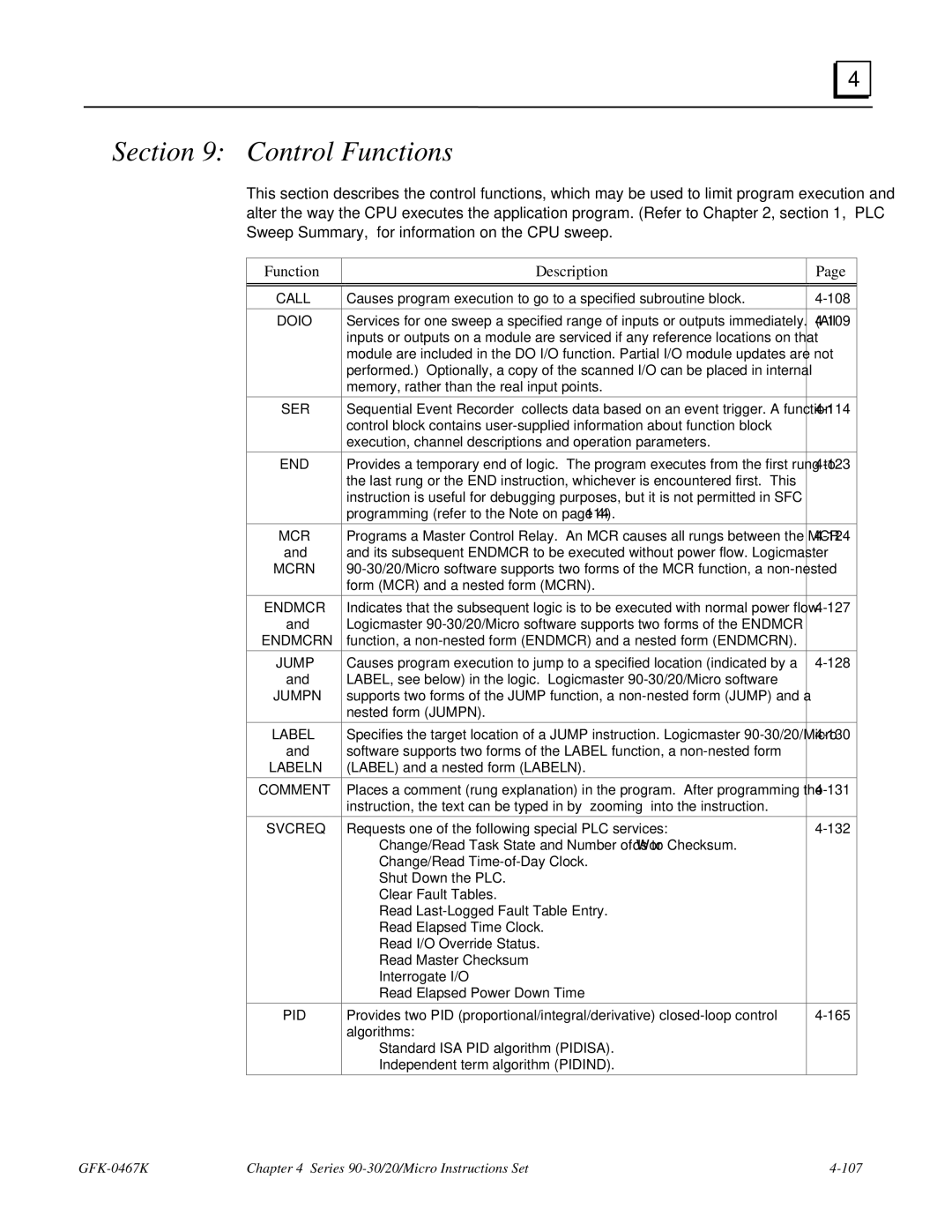4 |
Section 9: Control Functions
This section describes the control functions, which may be used to limit program execution and alter the way the CPU executes the application program. (Refer to Chapter 2, section 1, “PLC Sweep Summary,” for information on the CPU sweep.
Function |
| Description | Page |
|
|
| |
|
|
| |
CALL | Causes program execution to go to a specified subroutine block. | ||
|
|
| |
DOIO | Services for one sweep a specified range of inputs or outputs immediately. (All | ||
| inputs or outputs on a module are serviced if any reference locations on that |
| |
| module are included in the DO I/O function. Partial I/O module updates are not |
| |
| performed.) Optionally, a copy of the scanned I/O can be placed in internal |
| |
| memory, rather than the real input points. |
| |
|
|
| |
SER | Sequential Event Recorder— collects data based on an event trigger. A function | ||
| control block contains |
| |
| execution, channel descriptions and operation parameters. |
| |
|
|
| |
END | Provides a temporary end of logic. The program executes from the first rung to | ||
| the last rung or the END instruction, whichever is encountered first. This |
| |
| instruction is useful for debugging purposes, but it is not permitted in SFC |
| |
| programming (refer to the Note on page |
| |
|
|
| |
MCR | Programs a Master Control Relay. An MCR causes all rungs between the MCR | ||
and | and its subsequent ENDMCR to be executed without power flow. Logicmaster |
| |
MCRN |
| ||
| form (MCR) and a nested form (MCRN). |
| |
|
|
| |
ENDMCR | Indicates that the subsequent logic is to be executed with normal power flow. | ||
and | Logicmaster |
| |
ENDMCRN | function, a |
| |
|
|
| |
JUMP | Causes program execution to jump to a specified location (indicated by a | ||
and | LABEL, see below) in the logic. Logicmaster |
| |
JUMPN | supports two forms of the JUMP function, a |
| |
| nested form (JUMPN). |
| |
|
|
| |
LABEL | Specifies the target location of a JUMP instruction. Logicmaster | ||
and | software supports two forms of the LABEL function, a |
| |
LABELN | (LABEL) and a nested form (LABELN). |
| |
|
|
| |
COMMENT | Places a comment (rung explanation) in the program. After programming the | ||
| instruction, the text can be typed in by “zooming” into the instruction. |
| |
|
|
| |
SVCREQ | Requests one of the following special PLC services: | ||
| • | Change/Read Task State and Number of Words to Checksum. |
|
| • | Change/Read |
|
| • | Shut Down the PLC. |
|
| • | Clear Fault Tables. |
|
| • | Read |
|
| • | Read Elapsed Time Clock. |
|
| • | Read I/O Override Status. |
|
| • | Read Master Checksum |
|
| • | Interrogate I/O |
|
| • | Read Elapsed Power Down Time |
|
|
|
| |
PID | Provides two PID (proportional/integral/derivative) | ||
| algorithms: |
| |
| • | Standard ISA PID algorithm (PIDISA). |
|
| • | Independent term algorithm (PIDIND). |
|
|
|
|
|
Chapter 4 Series |
